
Posts Tagged: bedbugs
Teach 'em When They're Young
Nazzy Pakpour has a way with kids. At a recent Bohart Museum of Entomology open house, she read passages from her newly published children's book, Please Don't Bite Me: Insects that Buzz, Bite and Sting, and then encouraged questions. Each time a youngster raised a hand, she'd say...
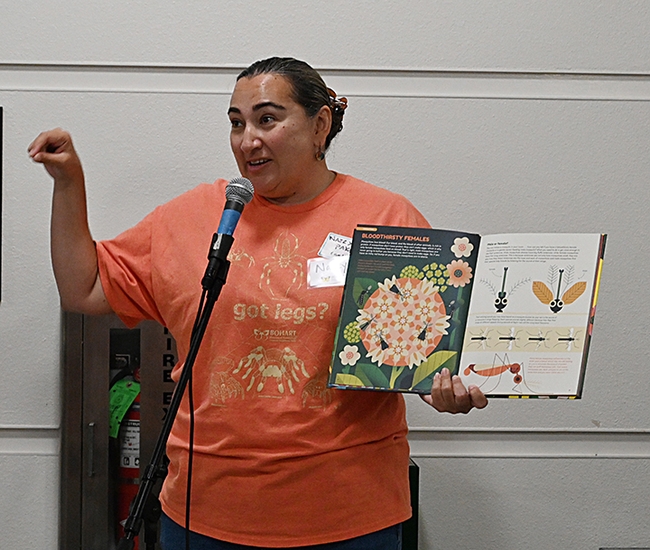
UC Davis alumna Nazzy Pakpour, who holds a doctorate microbiology, virology and parasitology from the University of Pennsylvania, reads from her children's book, "Please Don't Bite Me," at a recent Bohart Museum of Entomology open house. (Photo by Kathy Keatley Garvey)
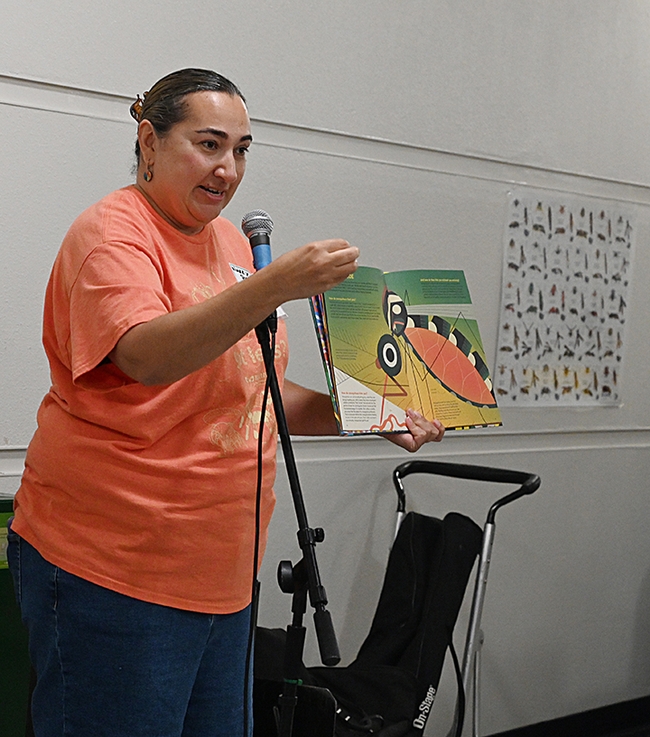
Nazzy Pakpour discusses fascinating facts about mosquitoes, lice, wasps, cockroaches, fleas, and bedbugs. She was a special guest at a Bohart Museum of Entomology open house. (Photo by Kathy Keatley Garvey)
Bedbug eradication requires tenant cooperation

California's pest management pros are divided over whether they believe that some of the state's bedbug populations are resistant to insecticides, but they agree that the bugs may survive treatments by finding safe harbor in excessive clutter and personal items that tenants didn't want treated or thrown away. In addition, some settings – such as hotels, motels, college dorms and homeless shelters – may be continually reinfested.
Bedbugs are among the most challenging and expensive pests to manage. Because they are so difficult to eradicate, the job is typically left in the hands of pest management professionals, who face an increasing number of bedbug infestations in California.
UC ANR scientists are working closely with pest management professionals in the state to find ways that will make bedbug eradication easier and more likely to succeed.
Bedbugs co-evolved with humans, and feed exclusively on blood. Their preferred habitat is inside warm rooms near where humans sleep and rest. Bedbugs are drawn to the carbon dioxide that humans exhale with every breath, and they seek out a blood meal by piercing the skin of a sleeping person. A few minutes later, they scurry back to hiding places.
According to an often-referenced annual report conducted nationwide by Orkin Pest Control, the San Francisco Bay Area is No. 14 on the list of 50 cities with the most calls for help controlling the pest. Sacramento-Stockton-Modesto, now at 27, jumped 14 spaces from 2013 to 2014. Los Angeles is fourth on the list, the highest of any area in California. A Terminix report said bedbug calls in Sacramento increased 54 percent from 2012 to 2013, more than any other city in the nation.
“Increases in bedbug infestations may be partly due to changes in the way we manage household pests,” said Andrew Sutherland, the urban integrated pest management advisor for UC ANR in the Bay Area. “In the 1930s and 40s, DDT was commonly used indoors. The pesticide is very persistent and effective and controlled all indoor pests, including bedbugs, sometimes for years.”

When Sutherland was hired three years ago, he realized there was little information available about obstacles to bedbug control in California.
“Most of the information about bedbugs is from research taking place in the Midwest and the Eastern Seaboard,” he said.
UC ANR awarded funds to Sutherland and Dong-Hwan Choe, a UC ANR urban pest specialist based at UC Riverside, to collect data from those who were on the frontline in the battle against bedbugs – pest management professionals and managers of multi-unit housing facilities. The researchers later received funds from the USDA's Western IPM Center to expand the study to 13 western states.
Early results of Sutherland and Choe's surveys showed that 75 percent of pest management professionals said bedbug infestations in 2014 had increased from the previous year. Forty percent said they believed they have encountered bedbugs that were resistant to insecticides, while 60 percent said they had not.
“There was no correlation between the amount of experience the professionals had and their perception about bedbug resistance in California,” Sutherland said.
The most common way for professionals to become aware of bedbug infestation has been visual inspections after complaints by tenants. Now, prevention is on the rise, an important component of integrated pest management.
“Our objective is to manage pests below unacceptable levels with minimal negative impacts on communities and the environment,” Sutherland said. “Prevention comes before all other management practices.”
The survey found that pitfall traps (interceptors) are used at least sometimes by 40 percent of pest management respondents to monitor for the pests. Active monitors, glue board monitors and harborage or shelter monitors are also employed.
The pest management professionals reported using a wide variety of treatments against bedbugs. Insecticides were most common, used by 91 percent of respondents most of the time. Desiccants, encasements and heat were used most of the time by about half of respondents.
Housing managers had similar responses to the survey questions. Bedbug control is challenging, they reported, when tenants don't report infestations, are not willing or able to prepare their living space for treatment, when tenants bring secondhand furniture into their units, and when they fail to take information about the pest seriously.
One housing manager respondent complained about an “almost total inability to prevent infestation, or to prove its source and (having to shoulder) almost total responsibility for all concomitant costs.”
For detailed information on bedbug life cycle, detection and treatment, see the UC IPM Pest Note on bedbugs.
An initiative to manage endemic and invasive pests and diseases is part of UC Agriculture and Natural Resources Strategic Vision 2025.
Bedbugs prove difficult to detect
UC scientists combat resurgence of bedbug in behavioral studies and monitor trials
Bedbugs are showing up more frequently in California and around the world, and new UC research shows that current methods for detecting the blood-sucking pests aren’t very reliable.
Detecting bedbugs is key to controlling them so a UC study tested three commercial monitors. At best, the monitors containing attractants captured 10 percent of the bedbugs, wrote UC scientists from UC Cooperative Extension, UC Berkeley and UC Riverside in the July–September 2013 issue of California Agriculture, UC's peer-reviewed journal of agricultural, natural and human resources.
As bedbugs become more prevalent, the researchers call for improving monitors as well as developing new methods to lure the insects more effectively.
“If we could put out bait and the bedbugs find it and die, wouldn’t that be great?” said Vernard Lewis, UC Cooperative Extension specialist in the Department of Environmental Science, Policy and Management at UC Berkeley and lead author of the article. Lewis is testing attractants for bedbugs and observing their behavior.
In Villa Termiti, a room built for studying insects, Lewis set up an experiment to see how far the bedbugs moved in a 24-hour period. He found that the bedbugs moved around to a bed, rug or low table, but most stayed close to the cardboard on which they were released in the middle of the floor. The monitors containing attractants captured up to 10 percent of the bedbugs, twice as many as the monitors that didn’t contain attractants, but not a statistically significant difference.
Lewis and his colleagues are studying new ways of detecting bedbugs and exterminating them.
Effective detection to determine the effectiveness of treatments made to eliminate bedbug infestations would be helpful. “When a property is treated and bedbugs reappear, at this point, we can’t tell whether the bedbugs survived the treatment or they are moving in from next door,” Lewis said.
The Lewis Lab is also exploring new methods of bedbug control that minimize the use of pesticides.
Co-author Dong-Hwan Choe, UC Cooperative Extension specialist in the Department of Entomology at UC Riverside, is currently studying essential oils from plants such as clove and wintergreen to see if they can be used as alternatives to synthetic insecticides.

Andrew Sutherland, UC Cooperative Extension advisor for the San Francisco Bay Area, has been meeting with pest control professionals to share the latest bedbug research results and integrated pest management approaches to minimize the amounts of pesticides used.
Sutherland also has begun training UC Master Gardener volunteers to answer questions about bedbugs and to share information about integrated pest management to control insects in the home.
“Master Gardeners in urban counties increasingly get requests regarding household pests,” said Sutherland. “UC ANR is interested in providing education and outreach on this topic because urban pest management significantly impacts water quality and other environmental resources. I have designed a 'Household Pests' unit used in 'Advanced IPM Training' for Master Gardeners.’”
“Master Gardeners will be able to help residents identify bedbug specimens and direct the general public to our Pest Note at http://www.ipm.ucdavis.edu/PMG/PESTNOTES/pn7454.html,” he said.
“Many clients think they may have bedbugs, but actually have recovered specimens of other insects,” Sutherland said. “In those cases we are able to prevent unnecessary and sometimes dangerous pesticide applications. When bed bugs are identified, our message is always to contact a professional pest control operator.”

The exact causes of the bedbug resurgence are not known, but increased international travel among people, pesticide resistance among bedbugs, the ease with which bedbugs can spread, and reduced indoor use of residual insecticides may be contributing factors.
The bedbug article in the July–September 2013 issue of California Agriculture can be downloaded at http://californiaagriculture.ucanr.edu.
Bed Bugs at the Bohart
Bed Bugs at the Bohart? Indeed. Those attending the Bohart Museum of Entomology's open house on Saturday, Feb. 2, will see them--and see them feeding. The Bohart Museum of Entomology is one of six museums or educational centers on the UC Davis campus holding an open house from 1 to 4 p.m....
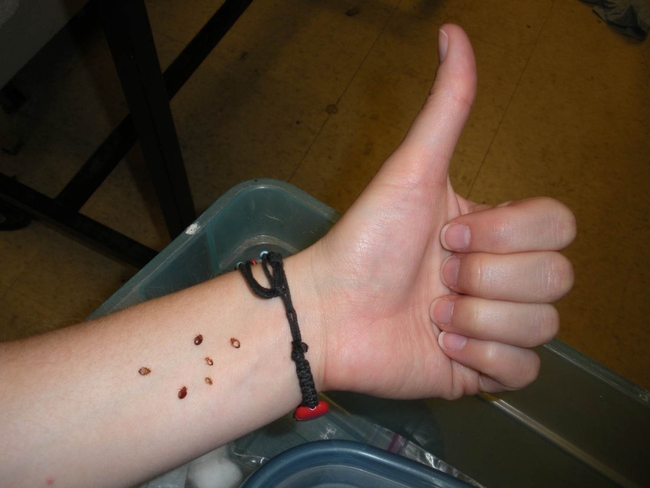
The arm of Danielle Wishon and her bedbugs, feeding.

Close-up of a bedbug in the process of ingesting a blood meal. (Photo courtesy of the Centers for Disease Control for Prevention, image by Piotr Naskrecki)
Don't Let the Bedbugs Bite
Forensic entomologist Bob Kimsey (right) of the Department of Entomology, University of California, Davis, studies bedbugs--those little bloodsuckers that prey on you while you're sleeping. There's an "alarming resurgence in the population of bedbugs" in the United States, according to the...
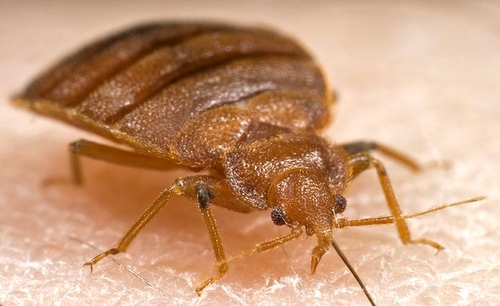
Bedbug
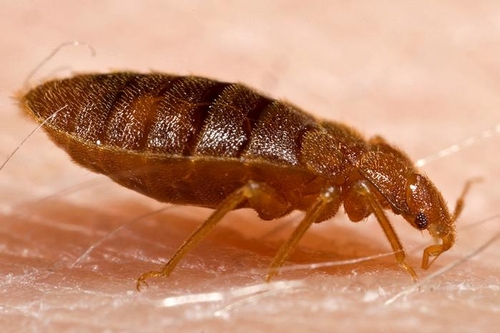
Close-Up
